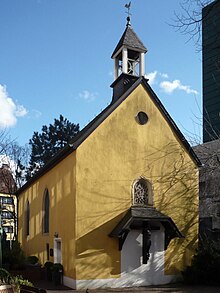Siechenkapelle (Rüttenscheid)
The Siechenkapelle is a listed , Catholic church building in Rüttenscheid , a district of Essen .
History and architecture
After leprosy was brought in by crusades and pilgrimages , an infirmary was already mentioned as a landmark in the 14th century. The oldest known foundation for this comes from the year 1410. It was built as an infirmary or leper house outside the Essen city wall with a chapel to care for the sick . It was supposed to accommodate sick people from whom the townspeople assumed contagion. It was administratively subordinate to the provisional staff of the Heiliggeist Hospital (at what later became Kopstadtplatz ). In 1488 this task was taken over by a separate provisional (administrator). The foundation took over part of the costs for the maintenance of the building and half for the soul masses, which, however, were read in the Heiliggeistkapelle and linked there with a donation to the inmates. In addition to the sick, a caretaker as well as one or more servants and one or more maids lived in the infirmary. A kind of house rule from the 15th century says that the sick had to bring a bed and dishes and, if possible, had to go shopping in the infirmary. Their legacies had to be made available to the house. It did not make any major fortunes through heirs or endowments. Bills from the 16th century show that there were still seven sick people in the infirmary at that time. In 1644 it was still a leper. It has not been established whether there was any kind of medical care, and no cure was expected. From 1726 the leper house was leased for agricultural purposes and as a residential building. Nothing is left of him today.
The associated and now preserved infirmary chapel is a small plastered hall building, built between 1426 and 1445. Masses were held here twice a week, which was made possible by small donations from an Essen priest and a vicar. The chapel has thirty seats and its shape has hardly changed. The interior is plastered, and a flat wooden ceiling has been put under the gable roof. The respective rector was also responsible for pastoral care. The priest Josef Varnhorst had a vicariate built through his larger foundation in 1476 , which was connected to a residential house by the chapel and some land. The priest appointed by the mayor and the council performed the altar service. It was intended to be a member of the Varnhorst family, or at least a citizen of Essen. Later they were members of the Mittweg family, who were related by marriage to the Varnhorst family.
Until the Ludgeruskirche in Rüttenscheid was completed in 1890, the chapel, which was expanded with a wooden extension, remained the parish's only church. After that it also served profane purposes. Under the direction of the government master builder Emil Jung , the chapel was extensively renovated in 1932, the roof renewed and the interior and exterior plaster applied. The roof turret was overhauled and the benches revised. The stained glass windows are works by the Soest artist Hans Kaiser .
The chapel was largely destroyed in World War II and rebuilt in 1950/1951 on the initiative of the Catholic Association of Academics. In 1971 it opened as an adoration chapel. After another thorough renovation, the chapel was returned to its intended use in October 2009. The former white paint gave way to today's characteristic yellow.
Furnishing
The altar from 1629 with a Latin inscription showed a sick girl. The new altar is a work by the sculptor Johannes Niemeyer from Wiedenbrück. For the tabernacle , the altar cross and the candlestick, Niemeyer used, as far as possible, pieces of objects destroyed in the war. The copper-gilded roof cock from 1758 was found in the rubble of the bombed-out neighborhood. A medieval Pietà stands behind a protective grille .
The hand-rung bronze bell from 1738 weighs around 40 kilograms. After it showed a vertical crack and the clapper tore off when Bishop Luthe was present, it has not rang the bell since 2002. It was welded at a company in Nördlingen and reattached in August 2012.
The Siechenkapelle has been a listed building since 1985.
literature
- Georg Dehio , edited by Claudia Euskirchen, Olaf Gisbertz, Ulrich Schäfer: Handbuch der deutschen Kunstdenkmäler. North Rhine-Westphalia I Rhineland . Deutscher Kunstverlag , 2005, ISBN 3-422-03093-X
- Heinz Dohmen: image of heaven, a thousand years of church building in the diocese of Essen . Verlag Hoppe and Werrry, 1977
Web links
- Monument to the Siechenkapelle (PDF; 478 kB)
Individual evidence
- ↑ a b Monika Fehse: Food. History of a city . Ed .: Ulrich Borsdorf. Peter Pomp Verlag, Bottrop, Essen 2002, ISBN 3-89355-236-7 , p. 227, 228 .
- ↑ Infirmary chapel shines. In: Derwesten.de of October 25, 2009; last viewed on August 23, 2012
- ↑ The bell of the infirmary chapel in Essen rings again after ten years. In: Derwesten.de of August 22, 2012; last viewed on August 23, 2012
Coordinates: 51 ° 26 ′ 4 " N , 7 ° 0 ′ 18.2" E
